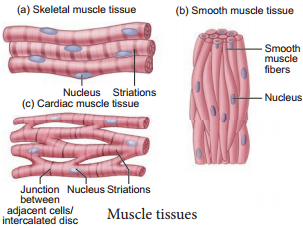Learninsta presents the core concepts of Biology with high-quality research papers and topical review articles.
Muscle Tissue Function and Its Types
Each muscle is made of many long, cylindrical fires arranged in parallel arrays. These fibres are composed of numerous fine firils, called myofirils. Muscle fires contract (shorten) in response to stimulation, then relax (lengthen) and return to their uncontracted state in a coordinated fashion. In general muscles play an active role in all the movements of the body.
Muscles are of three types, skeletal, smooth and cardiac. Skeletal muscle tissue is closely attached to skeletal bones. In a typical muscle such as the biceps, the striated (striped) skeletal muscle fires are bundled together in a parallel fashion. A sheath of tough connective tissue encloses several bundles of muscle fires (You will learn more about this in Chapter 9).
The smooth muscle fires taper at both ends (fusiform) and do not show striations (Figure 3.7). Cell junctions hold them together and they are bundled together in a connective tissue sheath. The walls of internal organs such as the blood vessels, stomach and intestine contain this type of muscle tissue. Smooth muscles are ‘involuntary’ as their functions cannot be directly controlled. Unlike the smooth muscles, skeletal muscles can be controlled by merely thinking.
Cardiac muscle tissue is a contractile tissue present only in the heart. Cell junctions fuse the plasma membranes of cardiac muscle cells and make them stick together. Communication junctions (intercalated discs) at some fusion points allow the cells to contract as a unit, i.e., when one cell receives a signal to contract, its neighbours are also stimulated to contract.
